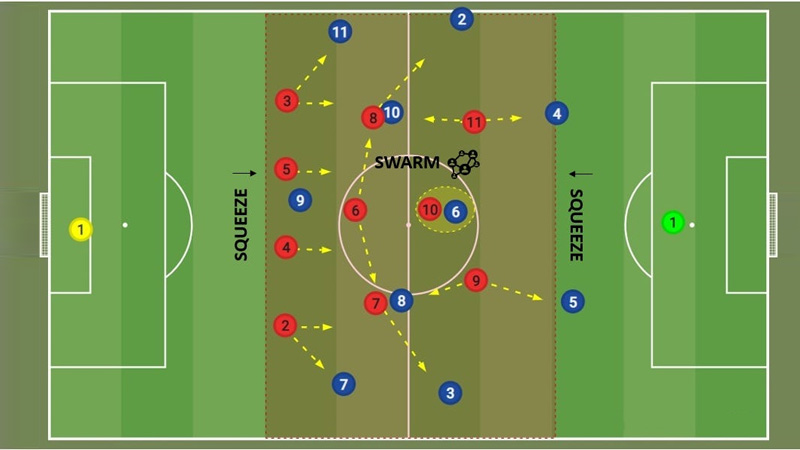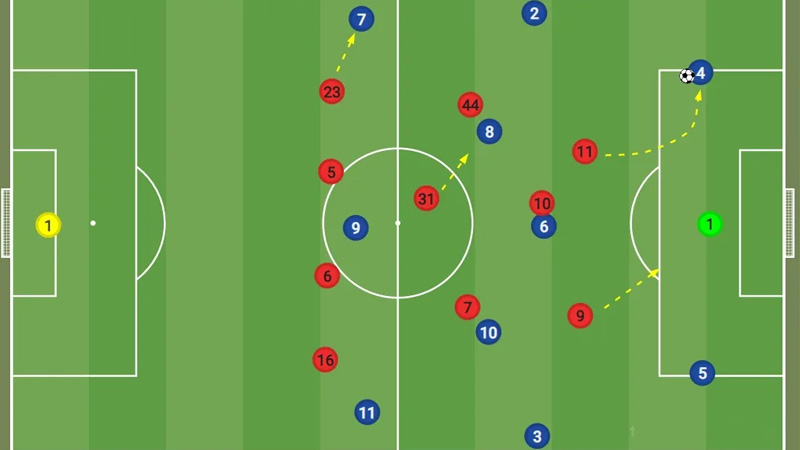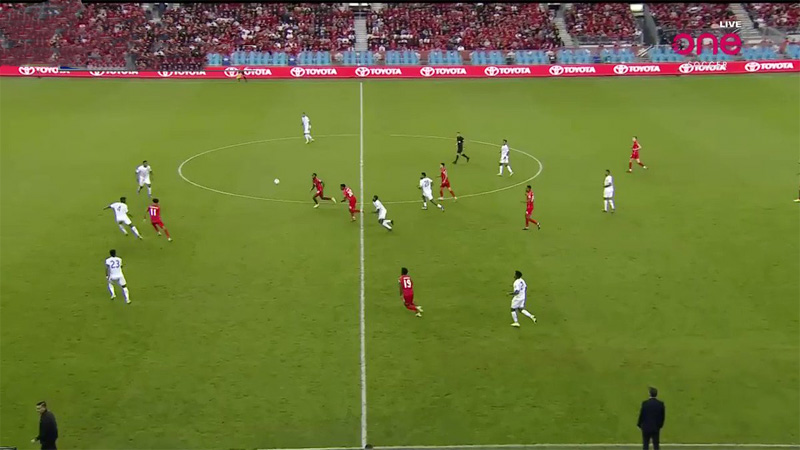Soccer, the world’s most beloved sport, offers a thrilling display of skill, strategy, and teamwork. At the heart of the action lies the soccer middle third, a pivotal battleground where matches are often won or lost.
This central area of the field serves as a conduit between defence and attack, demanding players to demonstrate exceptional tactical awareness, technical finesse, and communication.
As players vie for control of the ball in this critical zone, the middle third becomes a dynamic space where quick decision-making, precise passing, and defensive diligence reign supreme.
In this article, we delve into the intricacies of the soccer middle third, exploring the tips and techniques that enable players to excel in this vital realm of the game.
What Is Soccer’s Middle Third?
In soccer (also known as football in many countries), the field is divided into three sections: the attacking third, the middle third, and the defensive third. These divisions help players and coaches better understand the different areas of the field and their strategic significance during a match.
The middle third, as the name suggests, refers to the central part of the soccer field. It is the area between the attacking third (the opponent’s half) and the defensive third (the team’s own half).
It is often considered the engine room of the game, where midfielders play a crucial role in linking the defensive and offensive lines, distributing the ball, and launching attacks.
How To Play Soccer Middle Third?

Source: medium
Playing in the middle third of the soccer field requires a combination of tactical awareness, technical skills, and teamwork.
Here are some key aspects to consider when playing in this crucial area of the pitch:
Positioning and Spacing
Players in the middle third must maintain proper positioning and spacing to offer passing options and create passing lanes.
Midfielders should spread out across the width of the field, providing teammates with options both centrally and on the flanks.
Additionally, they should adjust their positioning relative to the ball and the opposition to maintain a balanced formation.
Ball Control and Passing
Good ball control and accurate passing are essential in the middle third. Players must be comfortable receiving the ball under pressure and quickly distributing it to teammates.
Short, crisp passes are often used to retain possession and advance the ball up the field.
Vision and Awareness
Midfielders need to have excellent vision and awareness of their surroundings. They should constantly scan the field to identify open spaces, potential passing lanes, and opponents’ positions.
Being aware of both teammates and opponents helps make better decisions and maintain possession effectively.
Winning Second Balls
In the middle third, the play can be quite competitive, with many 50-50 challenges for loose balls. Players should be prepared to win second balls after tackles or aerial duels.
Reacting quickly and decisively to regain possession or launch a counter-attack is crucial.
Transition Play
The middle third is where transitions from defence to attack and vice versa often occur.
Midfielders play a vital role in quickly switching the point of the play, initiating counter-attacks, or slowing down the opposition’s attacks when on defence.
Supporting the Attack and Defense
Midfielders must be versatile in their play, providing support to both the attacking and defensive phases of the game.
They should contribute to offensive movements, making well-timed forward runs and assisting in goal-scoring opportunities.
Simultaneously, they need to track back and help their defensive teammates when the team is out of possession.
Communication
Effective communication is essential in the middle third, as it allows players to coordinate movements, indicate their intentions, and alert teammates about incoming opponents.
Clear and concise communication helps maintain a cohesive and organized midfield.
Pressing and Defensive Shape
When not in possession, players in the middle third should press the opposition intelligently, trying to force turnovers or mistakes.
Maintaining a compact defensive shape helps restrict the opponent’s passing options and makes it more challenging for them to penetrate through the midfield.
By mastering these aspects and working cohesively as a team, players can effectively control the game in the middle third and influence the outcome of the match positively.
Common Mistakes Played In The Soccer Middle Third

Source: medium
Playing in the soccer middle third can be challenging, and certain common mistakes can hinder a team’s performance in this crucial area of the pitch.
Here are some typical errors that players should be aware of and try to avoid:
Lack of Movement and Support
One common mistake is when players in the middle third fail to provide enough movement and support to their teammates.
Standing still or not making proactive runs limits passing options for the player on the ball and allows opponents to close down space more easily.
Overcomplicated Passing
Trying to execute overly complex passes in the middle third can lead to turnovers and counter-attacks for the opposition.
Players should prioritize simple and accurate passes, especially when under pressure, to maintain possession effectively.
Slow Decision-Making
In the middle third, players often have limited time on the ball due to increased opposition pressure.
Slow decision-making can result in missed passing opportunities or losing possession, giving the other team a chance to capitalize on the turnover.
Failure to Shield the Ball
Midfielders sometimes neglect to protect the ball adequately when receiving passes, which can lead to losing possession in dangerous areas.
Shielding the ball from opponents and using the body to create space is crucial for maintaining possession and gaining control.
Not Tracking Back Defensively
When the team loses possession in the middle third, midfielders must quickly track back to support the defensive line.
Failing to do so can leave gaps in the defence, making it easier for the opposition to exploit the space and create scoring opportunities.
Lack of Communication
Communication breakdowns in the middle third can lead to misunderstandings and misplaced passes among teammates.
Effective communication is essential to coordinate movements, indicate intentions, and ensure smooth transitions during the game.
Ignoring Defensive Duties
While midfielders often focus on contributing to the attack, neglecting defensive responsibilities can leave the backline vulnerable to opposition attacks.
Balancing offensive contributions with defensive duties is crucial for a well-rounded performance in the middle third.
Being Overcommitted to Attacking
While supporting the attack is important, midfielders must also be cautious about overcommitting in the offensive phase.
If they push too far forward and lose possession, it can expose the defence to dangerous counter-attacks.
Lack of Compactness
A team’s middle third should ideally maintain a compact shape to limit space for the opposition.
When players are spread too far apart, it becomes easier for the opponents to exploit gaps and find passing lanes.
Ignoring the “Safe Pass”: There are situations when attempting risky or ambitious passes in the middle third may not be the best option.
Players should recognize when it’s wiser to play a safe pass and reset the play rather than risking a turnover in a critical area of the field.
By recognizing these common mistakes and working on individual and team improvements, players can enhance their performance in the middle third and contribute significantly to their team’s success.
Which Player Plays The Best Soccer Middle Third?
Identifying the single player who plays the absolute best in the soccer middle third is subjective and can vary depending on personal opinions.
However, several players have excelled in this position over the years. Here are some notable examples:
Andrés Iniesta
The Spanish maestro, Andrés Iniesta, was renowned for his exceptional performances in the middle third. With his impeccable ball control, close dribbling skills, and quick decision-making, Iniesta dictated play and orchestrated attacks effortlessly.
His ability to navigate through tight spaces and his vision to pick out precise passes made him a midfield genius.
Iniesta’s intelligence on and off the ball allowed him to dominate the middle third, earning him multiple titles with both Barcelona and the Spanish national team.
Xavi Hernández
Another Spanish midfield maestro, Xavi Hernández, was the epitome of a midfield controller. His passing accuracy and ability to read the game made him a crucial asset in the middle third.
Xavi’s visionary playmaking and positional awareness helped Barcelona dominate games, allowing them to control possession and dictate the tempo.
His influence on the team’s success during his prime years was unparalleled.
Luka Modrić
The Croatian midfielder Luka Modrić is known for his exceptional work in the middle third.
With his exceptional passing range, brilliant ball control, and tireless work rate, Modrić has been a key figure in both Real Madrid’s and the Croatian national team’s successes.
His ability to break lines with precise passes and his defensive acumen make him a complete midfielder in the middle third.
Toni Kroos
Another German maestro, Toni Kroos, has a remarkable presence in the middle third.
With his passing accuracy and ability to control the rhythm of the game, Kroos is a vital cog in Real Madrid’s midfield.
His vision, composure under pressure, and long-range passing abilities make him a formidable force in the middle of the park.
Kevin De Bruyne
The Belgian playmaker, Kevin De Bruyne, is a versatile midfielder who excels in the middle third.
With his powerful shooting, pinpoint passing and creative abilities, and De Bruyne is a constant threat in the attacking build-up.
His tireless work rate and defensive contributions also make him an asset in regaining possession for his team.
It’s important to note that each player brings their unique strengths and style to the middle third, and there are numerous other talented midfielders who have had significant impacts on the game.
The best player in the middle third can vary depending on the tactical system, team dynamics, and individual match situations.
FAQ
What is the soccer middle third?
Answer: The soccer middle third refers to the central area of the soccer field, situated between the attacking third (opponent’s half) and the defensive third (team’s own half).
It is a crucial zone where midfielders play a pivotal role in maintaining possession, orchestrating attacks, and transitioning between defence and attack.
Why is the middle third important in soccer?
Answer: The middle third is vital in soccer because it serves as the main conduit for both offensive and defensive play. It is the battleground where teams vie for control of the ball, and successful ball circulation through this zone often determines the team’s ability to create scoring opportunities.
What skills are essential for playing in the soccer middle third?
Answer: Playing effectively in the middle third requires a combination of skills. Key attributes include excellent ball control, passing accuracy, vision to spot open spaces and teammates, quick decision-making under pressure, defensive awareness to intercept passes, and the ability to shield the ball from opponents while under possession.
How can players dominate the middle third?
Answer: Dominating the middle third requires effective teamwork and individual contributions. Players must maintain optimal spacing to create passing lanes and passing options.
What are common mistakes players make in the soccer middle third?
Answer: Players often make mistakes in the middle third, such as overcomplicating passes, making slow decisions, neglecting defensive duties, or failing to shield the ball from opponents.
Conclusion
The soccer middle third, a vibrant realm of transitions and creativity, has been the stage for countless moments of brilliance and drama throughout the history of the sport.
Mastering this zone demands a comprehensive skill set, incorporating sharp decision-making, fluid passing, and defensive prowess from the orchestrators who dictate play to the tireless workers who press relentlessly; players in the middle third shape the rhythm and flow of the game.
As soccer continues to captivate global audiences, the significance of the middle third remains steadfast, underscoring its role as the engine that propels teams towards victory.
With a deep understanding of the strategic nuances and an unwavering commitment to excellence, players can rise to the challenge and leave an indelible mark in the captivating theatre of the soccer middle third.







